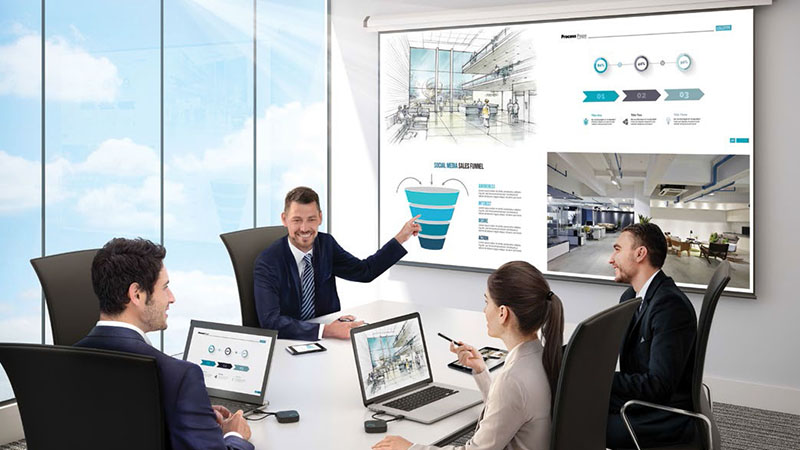Meeting Displays: Projection or Flat Panel?

With a greater focus on increasing productivity, accelerating the invention process while lowering travel costs and deepening the connection between remote participants, video collaboration isn’t a luxury, it’s a requirement. Recently, new advances in display technology have made video collaboration an even more compelling reason to invest in solutions. And at the same time, it’s an even more complex decision trying to choose between the latest projector or the interactive breeds of flatscreens.
While projectors have a long history of reliability that offers longevity for the investment, flatscreens have come down dramatically in price and boast features and resolutions that make them more appealing to the younger, more tech-savvy users that are entering the workforce. When it comes to video collaboration, there are a few considerations that will help you choose the best option to fit the space:
TALK TO YOUR USERS FIRST
While videoconferencing is a welcome addition for most users, don’t assume that every space will need videoconferencing capabilities. Otherwise, you’re investing in technology that will never be used. Talk to your users to determine which of their projects need videoconferencing tools, how many participants are expected on their calls, and where they most likely will meet. This will ensure you’re making the best purchasing decision.
MEASURE THE ROOM
It’s a safe bet that the larger the room, the bigger the screen. But you also want to make sure that everyone in the room can be in view of the camera and that everyone can see the screen. For larger boardrooms, that often means an HD projector. Midsize conference room have the most options. Usually it’ll require two 42-inch to 60-inch flatscreens to fit everyone on screen, but if the screen will be used for other content such as text, a projector will be a wiser decision. Video collaboration in huddle rooms often requires a 42-inch to 50-inch screen, depending on the size of the room and the number of participants and where they’re sitting.
FACTOR IN LIGHTING
One of the biggest reasons that enterprises often choose flatscreen displays over projectors is that ambient office lighting can wash out the picture. A quick fix in the past has been to dim the lights, but then participants are hard to see on the other end. The most recent alternative is a new offering of affordable, laser-based projectors. These projectors are designed with the same technology used in cinemas, so they’re designed to deliver a super bright image before the lights even go down. While they do require a higher upfront investment, they don’t require regular lamp replacements, filters, and additional maintenance that conventional lamp-based projectors require, so businesses can see a lower total cost of ownership.
ADD IN INSTALLATION VARIABLES
Another consideration is that flatscreens are heavy and large, which will take multiple people to lift and install. However, the screens usually only require access to power and a networking source that’s conveniently located along the same wall. Conversely, a projector takes one person to install but will require cables and inputs to be pulled to the ceiling or wireless connectivity features.
While there’s many factors that go into this decision, with a little bit of homework, tech managers can arrive at the solution that best fits the size of the room, the environment, the number of participants, and content requirements.
A daily selection of features, industry news, and analysis for tech managers. Sign up below.
Bob Wudeck is senior director, business, education, and CinePro solutions at BenQ. He can be reached at Bob.Wudeck@BenQ.com.
